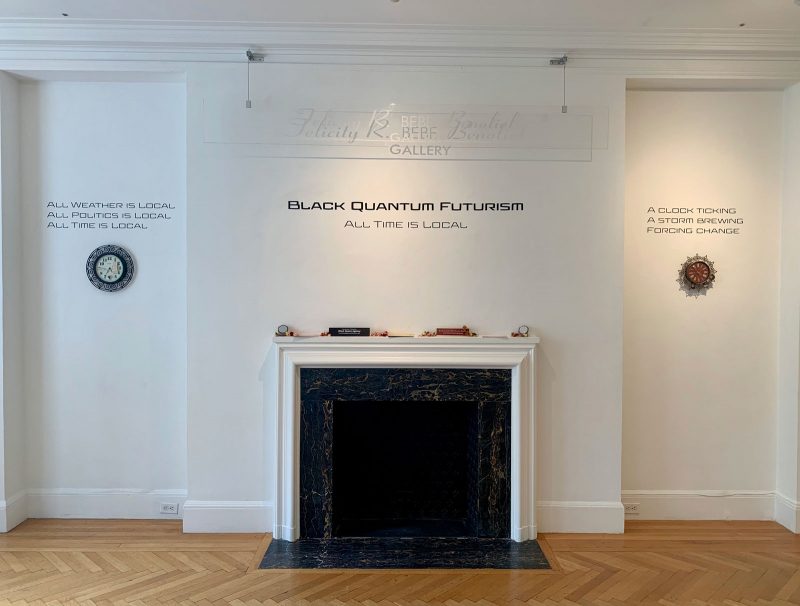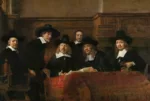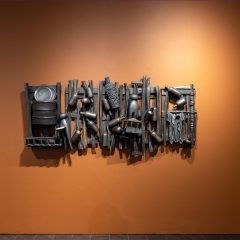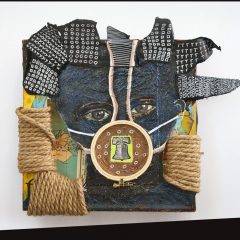
It doesn’t feel like hyperbole to say that one does not so much as enter into the tight, guest room-in-a-Brewerytown-basement apartment-sized space at the Center for Emerging Visual Artists to visit Rasheedah Phillips’s All Time Is Local, as one is more likely to be transported, completely and bodily, into an unexplored realm of Afrofuturistic possibility. Whether it’s the noisy, haunting soundscapes accessible by implanted phone line co-produced with enigmatic experimental noise-music artist Moor Mother, or the antique clocks wheat-pasted with the static cut-outs of newspaper clippings, the offerings look at displacement, particularly through the eyes of North Philadelphia’s Black residents, historically, presently, all simultaneously.
Each piece is a collage imbued with a subtlety of craft, mirroring a conjurer’s incantation. To be surrounded by the graying, jaundiced images portraying such hopeful idylls as worlds, futures even, that forward the notion of possibility for Black people, is disorienting–certainly the dystopian tone of the art pieces belie their stamped-on messages of transcendence. It’s this marrying of the mundane and the futuristic that is the defining ideology of All Time Is Local, and a hallmark of the time-travel and quantum physics inspired philosophy Phillips explores with her activist/artist group Black Quantum Futurism, which includes the work of her partner Moor Mother.
As abstract as the messaging and the pieces may appear to be, there is one idea that rings clear: that binary systems are unnecessary when discussing the show. In fact, they’re eschewed. For Phillips and BQF, the idea is to witness time and its side effects–struggle, progress, temporality–as something happening all at once, in the now, both past and future existing in a constantly malleable present. A set of watches adorned with the images of Black women activists and laypeople from all eras, are designed as, in the artists words, temporal disruptors done in homage to Black women healers who are often overlooked. The effect is stunning, especially in the context of the entirety of the show where 1960’s radical Black activists, like Eldridge Cleaver, are quoted in smeared-on text next to images highlighting leaders in aerodynamics and the space exploration movements of the era. One such innovator highlighted here is Philadelphia’s own Leon Sullivan, a Black capitalist who sought to use industrialization as a means for Black liberation. The constant pull between mulch-dichotomous Black arts and politics is not so much critiqued by Phillips–she doesn’t choose sides; at least not artistically per this exhibit– but instead, held in joyous tribute. One can’t help but imagine the somewhat small pieces shown in All Time also gracing the walls as murals on, say, a building in the Sharswood neighborhood of North Philadelphia, an area Phillips laments as being rapidly gentrified: astronaut suits are cut out and the faces of Black children poke through the helmet. There is a clear sentiment futurity so fully-embedded in the work.
The collages themselves breathe and are not overstuffed, as they feature exquisite line work combined with an understated use of found objects–think less the distortions of, say, Robert Rauschenberg and more Barbara Kruger inspired by steampunk tropes and early copies of the Black Panther newsletter. With stark images of Black folks dispersed through the landscapes the collages provide, the juxtaposition of ethereal elements of time travel and aeronautics helps the entire show avoid scrapbook-y moments that multimedia projects often tend towards, and by inferring absence in one piece, and envisioning inclusion in another–of Black people in space; of the reality of poverty and its relation to opportunity–the show asks us to deal with the concept of time in our own way. Phillips doesn’t spend time proving any thesis, instead they open you to the possible paths to arrive at hers: that all time, all systems, are local, and that temporality is in the eye of the beholder.
Black Quantum Futurism, “All Time is Local” at the Center for Emerging Visual Artists, Monday April 22nd, 2019- Friday, May 31st, 2019
Bio
Alex Smith is a Black queer Afrofuturist looking to disrupt the normative practices of traditional art, sound, and literature by dismantling their tropes piece by piece through his own collage-work, music and writing. His self-published book ARKDUST is a cyberpunk/retro-futurist blast of queer, afro-centric punk rock noise disguised as a pulpy short story collection. Join his irrevolution at alexoteric.com








